
2024 Changes to Skills First
Taking into account RTO’s need for certainty, the Department has offered a Skills First contract of 2-years duration. The longer-duration

The Evidence of Eligibility and Student Declaration Form is one of the most critical documents in your student file. No matter how many times your staff go through the Guidelines or participate in professional development, someone will always miss a checkbox or field which may result in breaches of the Contract. As part of the 2021 Contract, the Department has released an updated Evidence of Eligibility and Student Declaration Form which includes content and structural changes to reflect the introduction of new funding schemes (JobTrainer, Skill Sets etc.) and to provide further clarification on existing components of the form. In this article, we will review all of the significant changes in the 2021 Evidence of Eligibility and Student Declaration Form and provide detail on how each section of the form should be completed in a way that satisfies the requirements of the Contract.
When enrolling eligible individuals into either a Skills First funded Qualification or Skills First funded Skill Set, training providers are required to sight one of the identification documents listed on top of page 1. Apart from some terminology updates, the list of acceptable identification documents has not changed since last year.

However a couple of new checkboxes have been added in the section just below; one for sighting and retaining a digital green Medicare Card and another one for when a training provider relies on an identification document collected as part of a previous enrolment.
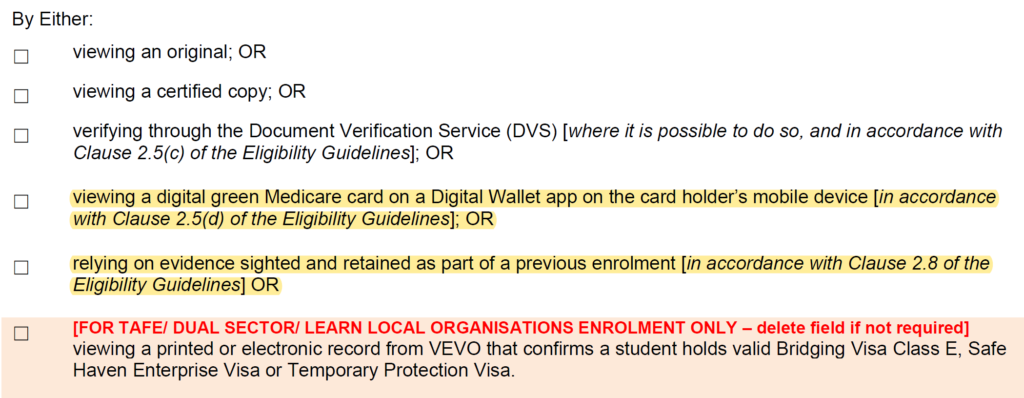
For the first time, the Department has allowed training providers to confirm citizenship/permanent residence by sighting a digital green Medicare Card displayed on a Digital Wallet through the Express Plus Medicare application on the cardholder’s mobile device. This has been an option for sighting evidence of concession but not for green Medicare Cards in the past. Training providers must sight the digital card through the mobile application and not via a screenshot or other means of reproduction.

Similarly to the evidence retained when sighting digital Concession Cards, training providers must retain a written declaration stating that the digital green Medicare Card has been sighted and including the following:
● Name of the authorised delegate who sighted the card
● Date the card was sighted
● Document number of the card
● Name of the cardholder
These are the checkboxes on page 1 of the Evidence of Eligibility and Student Declaration Form that should be ticked when sighting a digital green Medicare Card:
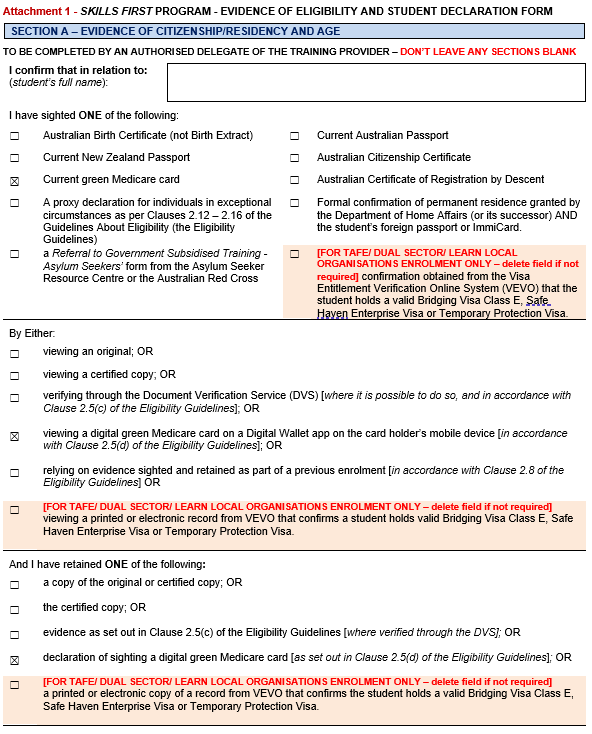
Under the new Guidelines about Eligibility, training providers may also use evidence of an individual’s citizenship/permanent residence that has been sighted and retained as part of a previous enrolment. Of course, this evidence must be valid and current at the time the subsequent enrolment occurs.
For example, you have enrolled an eligible individual into a funded program in January 2021. You have sighted their original Australian Passport, which expires in 2024, and have retained a copy of it. The same student is enrolling into another funded program with your organisation in July 2021. In this scenario, you may use the evidence of citizenship sighted and retained as part of January’s enrolment for the July’s one as well. If you choose to do so, these are the checkboxes that you should populate on page 1 of the Evidence of Eligibility and Student Declaration Form:
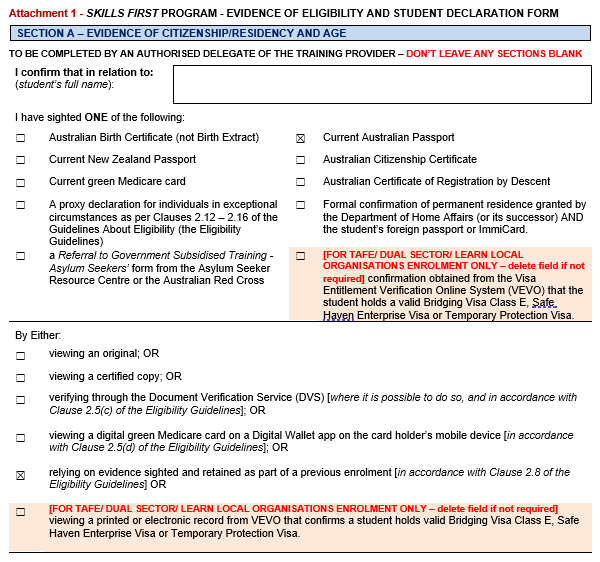
In the above situation, you may also use the “Notes” area under Section C to clarify further about the evidence that has been sighted and retained in relation to the subsequent enrolment:

Although the checkboxes in relation to sighting and retaining evidence when verifying identification information through the DVS have remained in place, the Department has added some clarification in the Guidelines about Eligibility on this. Clause 2.5 (c) requires training providers that engage with a Gateway Service Provider to sight verification that the individual’s name, date of birth (where applicable) and document number match a current and valid record in the DVS and to retain a transaction record that shows:

If you are currently using the DVS, then you need to check with your Gateway Service Provider to ensure that the transaction record that is retained within or extracted from their administrative platform displays all of the above information. Bear in mind that the date of birth can only be verified if it is displayed on the identification document therefore the transaction record will not show that the individual’s date of birth has been verified where the identification document collected is a green Medicare Card.
Here are the checkboxes that you should complete on page 1 of the Evidence of Eligibility and Student Declaration Form when verifying the information displayed on a current Australian Passport through the DVS:
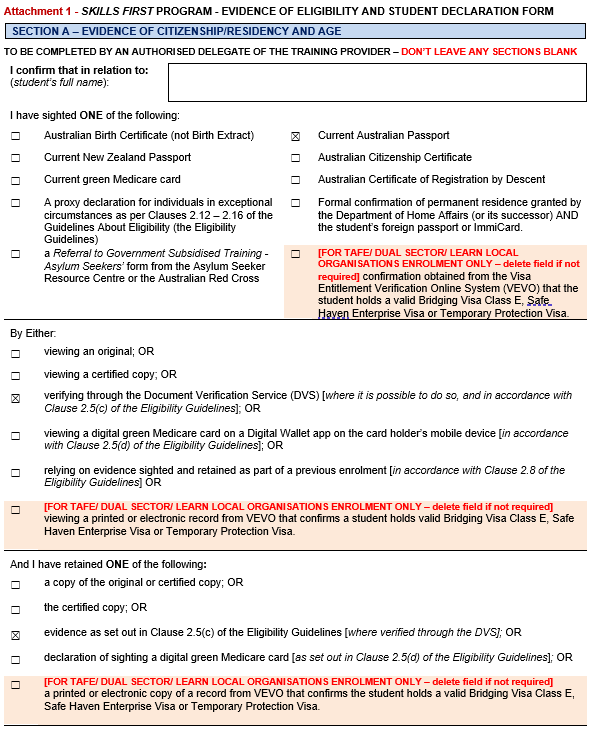
Training providers must offer individuals the opportunity to provide their evidence of eligibility in an alternative format if the DVS is unable to verify their identification documents. For instance, where the identification document presented by the student is a New Zealand Passport or Confirmation of permanent residence granted by the Department of Home Affairs then sighting and retaining evidence of eligibility must occur by means other than using the DVS.
There have not been any changes in this section of the form however this is an area which many training providers get wrong.
The student’s age is critical when identifying upskilling requirements. As stated in clause 1.3 of the Guidelines about Eligibility, an individual who is over 20 years of age (as at 1st January in the year of commencement of training) can only enrol at a higher AQF level than the highest qualification held at the time their training will commence.
There are five exemptions to the upskilling requirement:

Therefore, regardless of age an individual does not have to upskill when enrolling into a Foundation Skills course, as an apprentice, in VCE or VCAL and in a Skill Set. Training providers are not required to sight and retain any proof of age in the above enrolment scenarios, with the exception of the last dot point.
The only scenario where the upskilling requirement relates to the individual’s age is when the individual is under 20 years of age at 1st January in the year of commencement of training and wishes to enrol into a Skills First funded qualification, other than Foundation Skills, Apprenticeship and VCE/VCAL, that is at a lower qualification level than the highest qualification held at the time of the expected commencement. In such a case, the upskilling rule can be ignored as long as the Training Provider sights and retains proof of age for the eligible individual.
This evidence can be the same form of identification document that the Training Provider has used to determine whether the individual fulfils the citizenship/residence requirements (e.g. Australian or New Zealand Passport or Australian Birth Certificate). If the identification document used for this purpose does not include a date of birth (e.g. green Medicare Card) or the date of birth hasn’t been verified through use of the DVS, then the Training Provider must sight and retain one of the following:
This is an example where Training Providers must sight and retain proof of age:
In November 2021, John is currently 19 years and 10 months old and wanting to enrol in Certificate III in Individual Support. He has already completed a Certificate III in Business, not as part of his VCE/VCAL Certificate. Since he was under 20 years of age as at 1st January 2021, the upskilling rule isn’t applicable. However, proof of John’s age must be sighted and retained prior to course commencement.
The age relevance must be determined in conjunction with other Skills First Eligibility requirements. In the above example, if John had completed his Certificate III in Business as a School Based Traineeship then we would not have to sight and retain any proof of age for him, simply because any VET certificates completed as part of a senior secondary qualification are not taken into account when applying the upskilling criterion.
Training providers should be aware of when and how to fill out the relevant section on the Evidence of Eligibility and Student Declaration Form. If the individual’s age is irrelevant to their eligibility then the “Not applicable” checkbox must be ticked.

This is the section of the Evidence of Eligibility and Student Declaration Form where the most significant changes have been made. Section B is now separated into three different parts:

In addition, new wording and questions have been added to reflect the introduction of Skills First funding for Skill Sets and changes to Free TAFE for Priority Courses to align with JobTrainer. Both sections B1 and B2 include new questions for enrolments under JobTrainer.
Training providers can customise the Evidence of Eligibility and Student Declaration Form for different types of enrolments. For example, they may delete Section B2 completely if they do not deliver Skill Sets or remove the JobTrainer questions if they have not been granted a JobTrainer allocation or remove the TAFE/Dual Sector enrolment questions if they are a different type of training organisation. Also, if they embed the Evidence of Eligibility and Student Declaration Form into an Enrolment Application Pack which consists of several documents (e.g. Pre-Training Review form, LLN Assessment, Enrolment Form etc.), then they may include different versions of the Evidence of Eligibility and Student Declaration Form into each Enrolment Application Pack, depending on the type of enrolment (Qualification or Skill Set).
All basic eligibility requirements have remained in place. An individual can:
It is critical to remember that when determining the number of Skills First subsidised programs that the student is doing at the moment, unlike previous years, participation in both Skills First funded AQF qualifications and Skill Sets must be taken into account. For example, if an individual wishes to enrol into a Skills First funded AQF qualification and they are at that moment undertaking another Skills First funded AQF qualification and one Skills First funded Skill Set, then they are currently meeting the maximum number of Skills First funded programs they may commence at any one time.
In this scenario, their answer to question 3 under Section B1 of the Evidence of Eligibility and Student Declaration Form must look like this:

For more information about scenarios and types of enrolments that must not be taken into account when determining if a student meets the upskilling requirement and all the other limits, you should refer to the 2021 Guidelines about Eligibility.
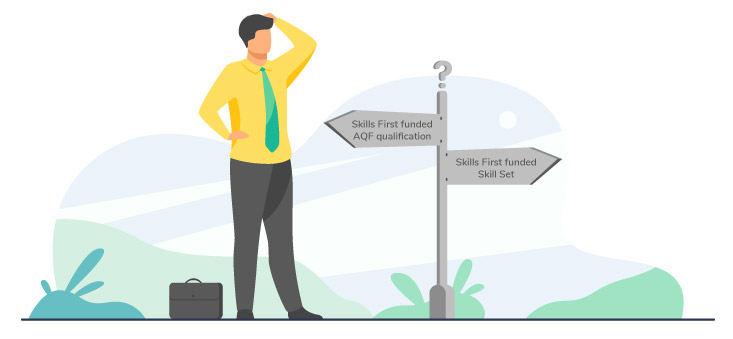
The Government has responded to skills shortages and workforce demands by subsidising the delivery of accredited skill set training under the Skills First program. To reflect this and to assist training providers with determining funding eligibility for individuals enrolling into Skill Sets, a new section has been created within the Evidence of Eligibility and Student Declaration Form.
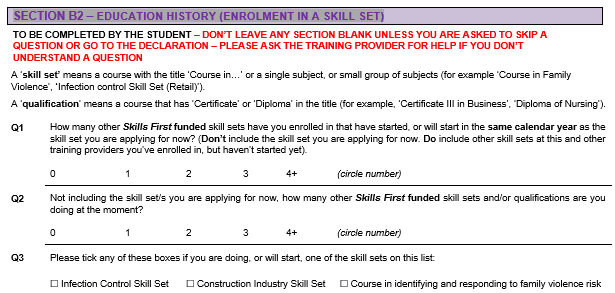
A skill set is an accredited program that is on the Funded Skill Set List and may include:
An individual person is eligible for skill sets if they meet the normal Skills First eligibility criteria, but with two exceptions:
The “2 in a year” limit still applies but skill sets and full qualifications are treated separately. As a result, a student can commence a maximum of two Skill Sets in a calendar year. The “2 at a time” limit also applies but, as already stated, it now applies collectively across both Skill Sets and AQF qualifications. For example, a student cannot undertake two Skill Sets and one AQF qualification at the same time.
If a student is applying to enrol into any of the Skill Sets listed in question 3 under Section B2 of the Evidence of Eligibility and Student Declaration Form then they must tick the relevant checkbox. This is because these Skill Sets have their own allocations and conditions under the Contract and are not impacted by the introduction of Skill Sets.
Questions about JobTrainer have been included in both Sections B1 and B2 and may be removed if your organisation has not been granted a JobTrainer allocation.

Under the Job Trainer initiative, Training Providers can enrol individuals into JobTrainer funded full qualifications even if:
Individuals can enrol into a Skills First funded program under Job Trainer if they are:
Also, in their lifetime a student can commence:
If an individual is eligible for the JobTrainer initiative due to their age, training providers are required to check their age using one of the accepted methods specified in the Contract and the Guidelines about Eligibility. If an individual is eligible for JobTrainer due to being a job seeker, then training providers are required to sight one of the following:
Let’s look at the following example:
This is how the training provider should complete page 1 of the Evidence of Eligibility and Student Declaration Form:
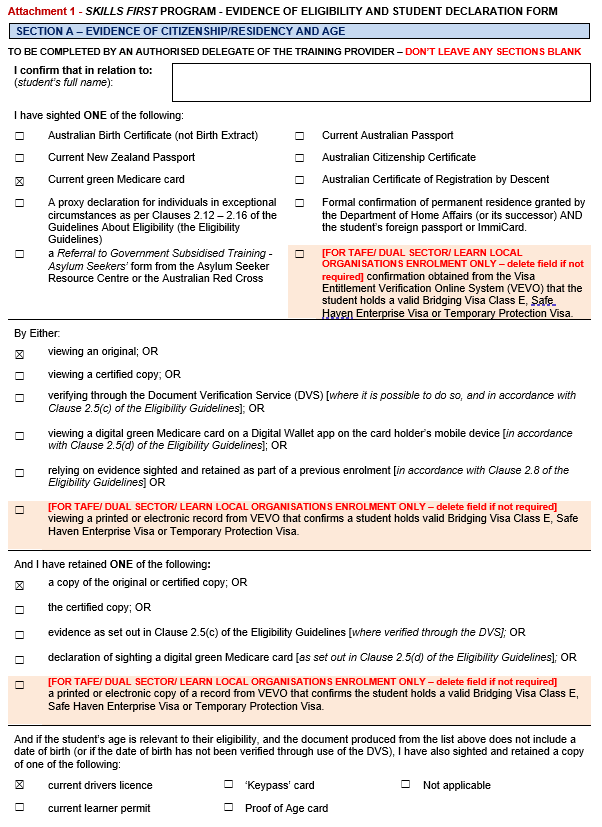
Additionally, the JobTrainer related questions must be completed by the student as follows:
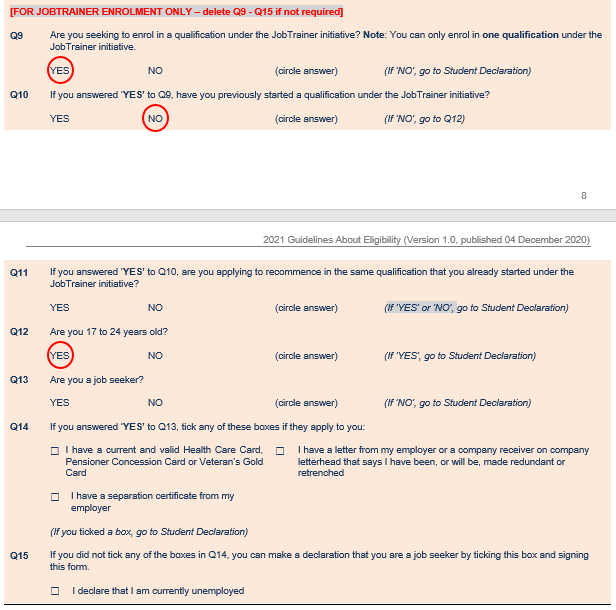
Since the individual is eligible for JobTrainer due to their age, they must skip all questions relating to whether they are a job seeker or not (questions 13, 14 and 15). If they qualify for JobTrainer due to both their age and being a Job Seeker, then training providers may choose one reason only for granting a JobTrainer exemption (e.g. age only) and ask the student to skip the irrelevant questions under the JobTrainer Enrolment Only section.
In the scenario where the student sits outside the eligible age bracket (17-24) but they are eligible for JobTrainer due to being a Job Seeker, the training provider does not need to sight and collect proof of age. They do need, however, to sight one of the forms of evidence outlined in questions 14 and 15. If the training provider has sighted a Concession Card in relation to an individual enrolling into a JobTrainer funded qualification for the first time, then the JobTrainer Enrolment Only section must be completed as follows:
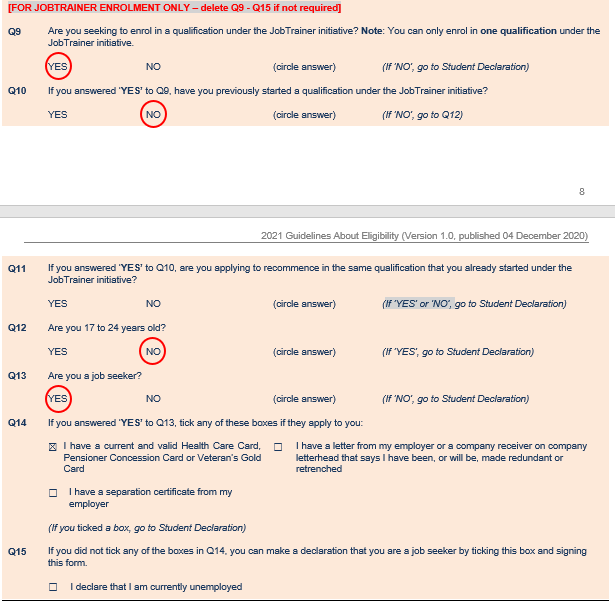
The significant change here is the inclusion of checkboxes relating to the number of Skill Sets that the student is currently eligible for:

Training providers may delete any sections that are not required. For instance, if they deliver only funded AQF qualifications and not Skill Sets then the question relating to the number of skill sets can be removed.

An easy way to ensure that the right number of qualifications or skill sets that the student is currently eligible for, is to remember that this always equals two minus the highest number circled under the Education History section of the Evidence of Eligibility and Student Declaration Form. If an individual fulfils the eligibility requirements and has been deemed eligible for one qualification, then Section C must be completed as follows:

If an individual has been deemed eligible after they have been exempted from one or more eligibility requirements and they are enrolling under the Eligibility Exemptions Initiative or the JobTrainer Initiative or another Government program where eligibility exemptions may be granted, then Section C must be completed as follows:

Last but not least, training providers should not underestimate the importance of the “Notes” area. This is where you can record additional information used to verify the student’s eligibility and has not been captured in Sections A or B. Examples of when to use the “Notes” area may include clarifications about the highest qualification that the student holds or recording the reason why an exemption under the Eligibility Exemption Initiative has been offered to the student.
For instance, if a student has declared under section B1 that they have completed a Diploma but through discussion with them you have identified that the Diploma is an overseas qualification and equivalency has not been formally established with an AQF level and, as a result, you have deemed the student eligible to enrol in a Certificate IV level qualification, then you should use the “Notes” area under Section C to record this.
This could be documented in the Evidence of Eligibility and Student Declaration Form as follows:


In conclusion, here is some advice on how to ensure that your 2021 Evidence of Eligibility and Student Declaration Form is completed in accordance to the Contract and the relevant Guidelines:


Taking into account RTO’s need for certainty, the Department has offered a Skills First contract of 2-years duration. The longer-duration

Managing the transition from superseded training products can be a complicated and time-consuming process for RTOs. From time to time,

According to the Audit and Assurance Findings Report by the Department of Education, Evidence of Participation (EOP) made the top 5 most common issues identified at audit. Make sure you’re on top of your EOP obligations!

The 2023 Victorian VET Funding Contract came with significant changes to the eligibility settings. In this article, we cover the 2023 changes relating to the Skills First eligibility requirements and evidence retention.

In an effort “to increase the ability of Victorians to reskill and to continue to participate in an evolving economy”,

Not all Skills First funded training conducted in the workplace translates into an apprenticeship/traineeship enrolment. It is common for Training

